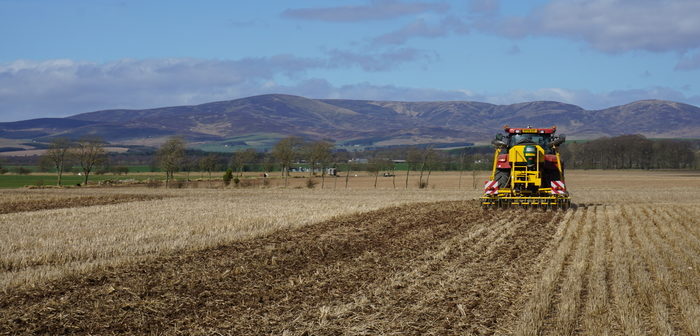Advice has been issued to growers on how to establish spring barley in a reduced tillage system and grow a profitable crop. Unlike the long growing season for crops such as winter wheat, the short lifespan of a spring barley crop makes establishment crucial for success.
The Farming for a Better Climate Soil Regenerative Agriculture group have been experimenting with ways to establish spring barley effectively for three years, and Peter Lindsay, Principal consultant at SAC Consulting and group facilitator, says there are a few key pointers to help farmers grow a successful crop:
Seed rate
An optimum seed rate is calculated based on the target number of plants per square meter. In reduced tillage systems, generally fewer seeds germinate due to uneven seed placement. Increasing the seed rate by 10 to 15% can help to offset the lower germination and ensure the target plant number is achieved. In Scotland, in late March / early April, a standard seed rate of 375s/sqm is normal, therefore in a reduced tillage system, increasing the seed rate to at least 415s/sqm would be prudent. However, soil type, weather conditions, variety choice and time of sowing can all effect the seed rate, so preparing tailored calculations is recommended.
Weed control
In reduced tillage systems, grass weeds such as annual meadow grass can be an issue. Ensuring good weed control is challenging, and often depends on the weather conditions at the time of sowing. Recent dry springs have reduced the effectiveness of pre-emergence herbicides which usually require a level of soil moisture for maximum efficacy. Using glyphosate just prior to sowing to create a clean seed bed is one way the Soil Regenerative Group has overcome this problem. This non-selective herbicide can ensure that all the weeds which have germinated are knocked back, particularly annual meadow grass, providing minimal competition for the spring barley crop to get established.
Sowing date
Altering the sowing date can also ensure good establishment in reduced tillage systems. Sowing between 7 and 10 days later than a conventional system can give the soils a few extra days to warm up and dry out. Under a conventional system, the operations of ploughing and cultivating the soil help to dry out the soil. Under reduced tillage this takes longer to happen, hence the need to delay drilling. The soil needs to be dry enough not to smear, but moist enough for the seed to germinate. However, in a dry spring, the direct drilled system will retain moisture much longer than the conventional plough-based system.
Rolling
Rolling after drilling under a reduced tillage method is recommended to help close the slot, aid seed to soil contact and to physically crush slugs and slug eggs and make it more difficult for slugs to move around. Slug pressure can be higher under a reduced tillage system as there is more cover for slugs to live under and breed, particularly if straw from the previous crop has been chopped. In high-risk situations some farmers are rolling twice, once immediately after drilling and again once the crop has emerged at a right angle to the direction of drilling.
For more information, please visit the Farming for a Better Climate website at https://www.farmingforabetterclimate.org/




